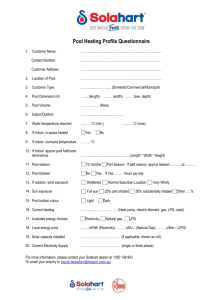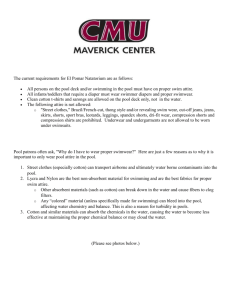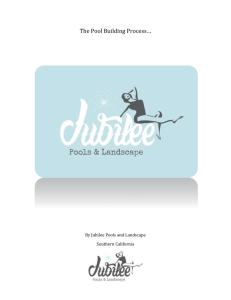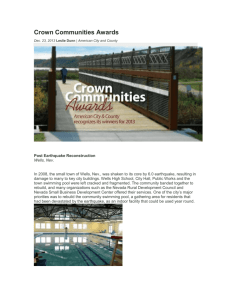FUN IN THE SUN! Grade 11: Pre
advertisement
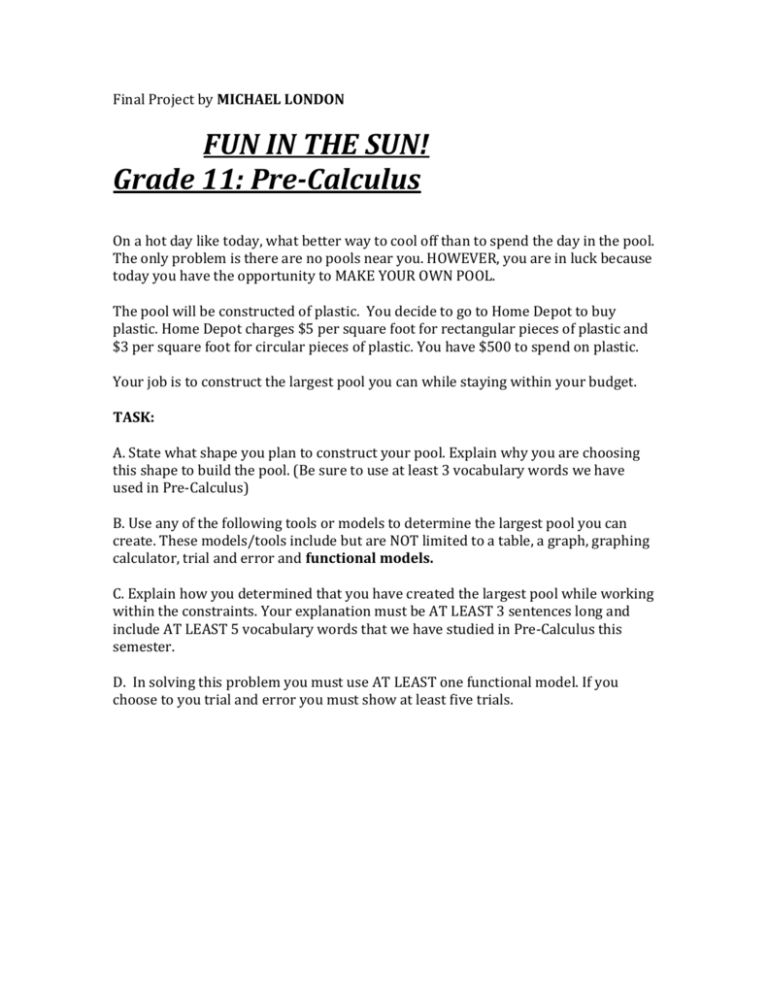
Final Project by MICHAEL LONDON FUN IN THE SUN! Grade 11: Pre-Calculus On a hot day like today, what better way to cool off than to spend the day in the pool. The only problem is there are no pools near you. HOWEVER, you are in luck because today you have the opportunity to MAKE YOUR OWN POOL. The pool will be constructed of plastic. You decide to go to Home Depot to buy plastic. Home Depot charges $5 per square foot for rectangular pieces of plastic and $3 per square foot for circular pieces of plastic. You have $500 to spend on plastic. Your job is to construct the largest pool you can while staying within your budget. TASK: A. State what shape you plan to construct your pool. Explain why you are choosing this shape to build the pool. (Be sure to use at least 3 vocabulary words we have used in Pre-Calculus) B. Use any of the following tools or models to determine the largest pool you can create. These models/tools include but are NOT limited to a table, a graph, graphing calculator, trial and error and functional models. C. Explain how you determined that you have created the largest pool while working within the constraints. Your explanation must be AT LEAST 3 sentences long and include AT LEAST 5 vocabulary words that we have studied in Pre-Calculus this semester. D. In solving this problem you must use AT LEAST one functional model. If you choose to you trial and error you must show at least five trials. RATIONALE: 1. I would like the students to work on this problem for a variety of reasons. The first is that I would like the students to see that the concepts they learned during the unit on functional models can be used to solve a problem that comes up in every day life. Furthermore, in the future the students will have to learn how to work within a budget. Consequently, this problem will give the students practice on how to get the most bang for their buck. Another reason for having the students work on this problem is to give them practice choosing an appropriate strategy for solving a problem. Finally, this problem allows the students to gain a higher-level understanding of the concept of a functional model. The first learning goal is for the students to be able to construct a viable argument for choosing the shape that they are going to use to build their pool. The second goal is for the students to gain experience choosing an appropriate problem strategy. The third goal is for the students to practice creating functional models. The last goal is for the students to use appropriate Pre-Calculus vocabulary to explain their reasoning. The first mathematical ideas I want the students to explore is how does changing the dimensions of a figure affect the area. Specifically I want the students to explore how they can create the biggest rectangle possible. Also I would like the students to explore how they can give a circle its maximum area. Another mathematical idea I want the students to explore is, how can the concept of a functional model of which they are familiar with would be applied to this situation. This task will engage the students in many of the mathematical practices addressed in the Common Core Standards. These practices include: Make Sense of Problems and persevere in solving them, reason abstractly and quantitatively, construct viable arguments an critique the reasoning of others, model with mathematics, use appropriate tools strategically, attend to precision and look for and make use of structure. 2. I would introduce this task around two months into the school year after I have completed the unit on functions and the sub-lesson on functional models. 3. In order to get ready to complete this task in the days before I assign it, I will constantly be reviewing the vocabulary words that we have learned in the unit on functions. Furthermore, the day before assigning this task, the students will have had practiced creating functional models so that the concept is fresh in their mind. Finally, I hope to have assigned other problems in which the students have to choose an appropriate strategy so that they are prepared to complete this task. The way I will introduce this task is to motivate the students by asking them what they like to do in the summer and what they need in order to engage in these activities. By asking these questions I am hoping to elicit the answers of going to the pool for an activity and the fact that they often have to work within a budget. I will then have a student read the problem aloud and then give the students one minute to think how they would solve the problem. Then I will take predictions from the students as to how they think the pool should be created. 4. Questions to ask the students: A. Why did you choose to use that strategy? B. In creating the largest pool is it more important to consider the area or perimeter? C. Does the entire pool have to be the same shape? D. How do you know that a bigger pool can’t be created? E. Is there a specific mathematical term you can use to more concisely explain your reasoning? 5. The way to modify this lesson would be to make the numbers smaller so that there would be fewer options to try if the students choose to use trial and error. Another way to modify this lesson is to give the students manipulatives in the shapes of rectangles and circles. A further modification that can be made is to give the students a word bank of vocabulary words that they can choose from when they construct their argument. Finally, I could provide the students with the area, perimeter and circumference formulas for a rectangle and a circle since I am not evaluating the students knowledge of the formulas, and if the students do not know those formulas they will not be able to engage in the higher-order thinking presented in this task. 6. I anticipate that the students will begin this task by drawing a lot of different pictures and perform some preliminary measurement computations. I believe that the students will use trial and error to initially come up with a hypothesis. After the students come up with a hypothesis I anticipate the students will create their functional model and then test the validity of their model using a table or a graph. One of the strategies the students will use is using trial and error to vary the dimensions of a circle or rectangle in order to find the greatest area. Another strategy the students will use is translating this situation into an appropriate functional model. The students will then use the strategy of expressing their functional model in terms of a graph or table. Finally, the students will use the strategy of using appropriate math vocabulary to justify a real life phenomenon. The models that the students may use are tables, graphs, equations, and functional models, charts and cut out rectangles and circles.


